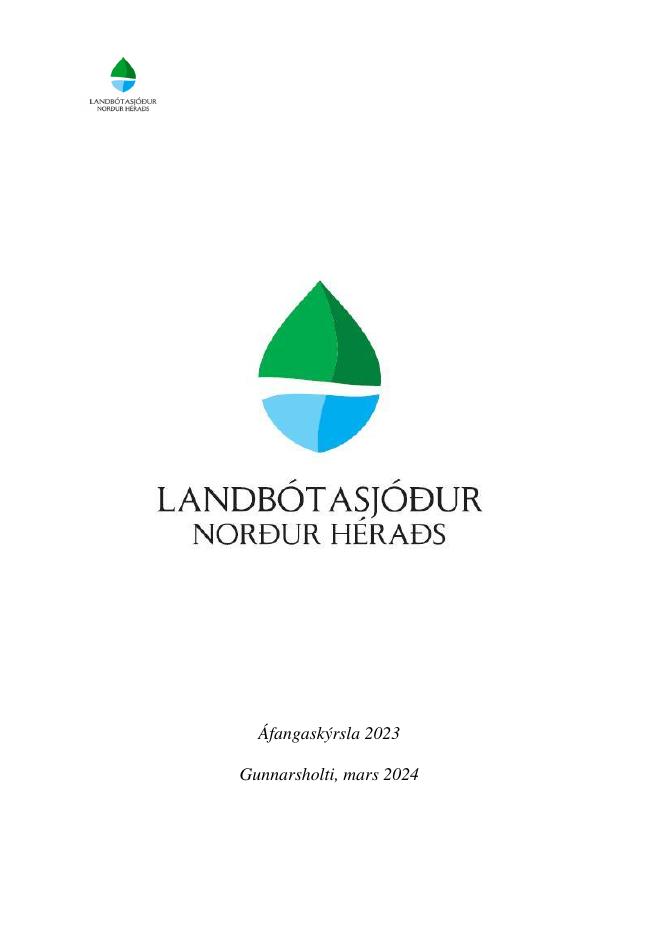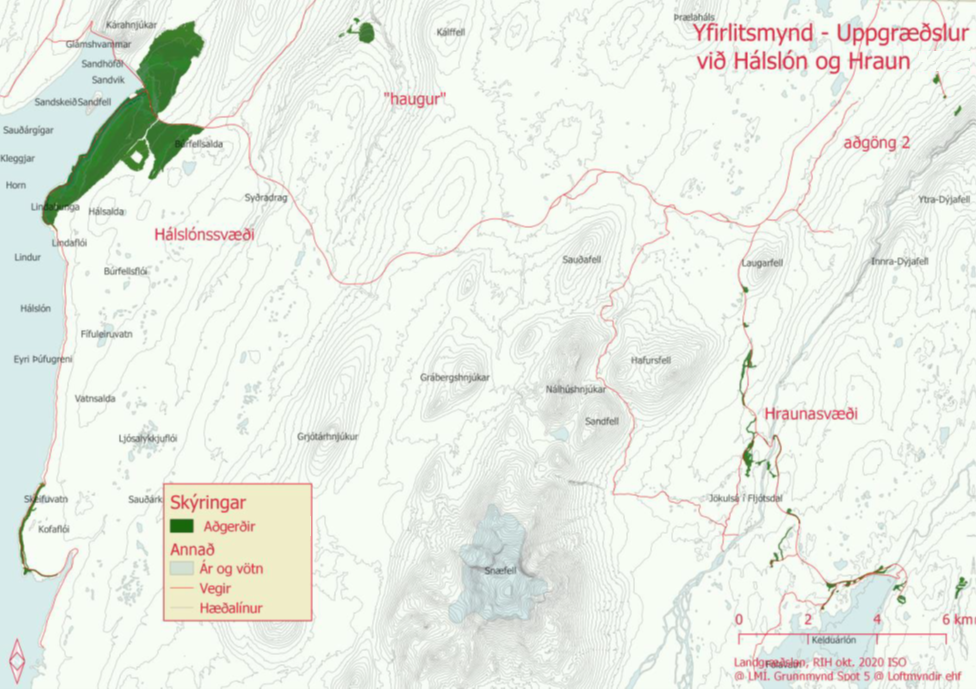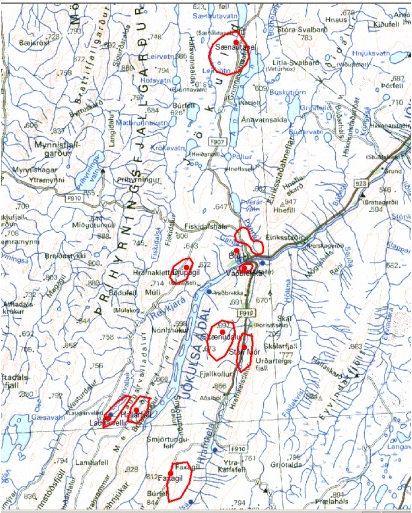Progress
Land reclamation on behalf of the Land Improvement Fund of Norður-Hérað has been ongoing for 17 years at Jökuldalsheiði Heath, with overall good results. Still, there is significant variability in conditions between areas, and the areas are at different stages of vegetation succession. Vegetation has increased, and a soil crust has started to build. Land reclamation procedures have slowed the erosion process in areas suffering soil erosion. Land reclamation at the bars of the Jökla River commenced in 2007. The vegetation reacts well to fertilizer and seeds. However, the water torrent of the Jökla River has destroyed parts of the land reclamation area, plus ice floes in wintertime seem to uproot the vegetation in some areas. It is too early to conclude about land reclamation progress in areas under the responsibility of the Land Improvement Fund of Fljótsdalshreppur, but results from inspected areas are promising.
Since 2009, fertilizer has been spread on barren areas east of the Hálslón reservoir to establish vegetation to withstand and bind possible aeolian deposition from the reservoir bed. The results have been outstanding most years, and the land reclamation area now covers about 780 ha. In 2012, land reclamation operations were started with fertilizer and seeds in the Hraun area, a disrupted former construction site. The area is sparse, high above sea level, and hard to vegetate. In 2017, reclamation began with fertilizer and sawing in damage to former construction sites in Tunga, between Glúmsstaðadalur and Þuríðardalur (valleys). The areas that have been worked on can be seen in the picture below.
Labels:
Aðgerðir: Operations
Vatnajökulsþjóðgarður: Vatnajökull National Park
Ár og vötn: Rivers and lakes
Vegir: Roads
Hæðarlínur: Contour lines
The tables below summarize land reclamation operations, and more information is available under the "Further reading" tab (only in Icelandic).
| Year | Area (ha) | Fertilizer (tons) | Hayseed (kg) |
|---|---|---|---|
| 2009 | 255 | - | - |
| 2010 | 350 | 63,3 | - |
| 2011 | 418 | 70,2 | - |
| 2012 | 361 | 64,8 | 530 |
| 2013 | 337 | 58,1 | 280 |
| 2014 | 290 | 49,2 | 480 |
| 2015 | 331 | 51,6 | - |
| 2016 | 394 | 59,4 | - |
| 2017 | 355 | 48,6 | - |
| 2018 | 314 | 57 | - |
| 2019 | 466 | 68,7 | - |
| 2020 | 536 | 73,8 | - |
| 2021 | 540 | 74 | - |
| 2022 | 540 | 70,8 | - |
| 2023 | 400 | 75 | 200 |
| Year | Area (ha) | Fertilizer (tons) | Hayseed (kg) |
|---|---|---|---|
| 2012 | 33 | 7,2 | 0,65 |
| 2013 | 43 | 10,1 | 540 |
| 2014 | 77 | 18 | 1.260 |
| 2015 | 51 | 12,6 | 630 |
| 2016 | 69 | 15,6 | 700 |
| 2017 | 76 | 17,4 | 320 |
| 2018 | 70 | 15,0 | 160 |
| 2019 | 0 | 0 | 0 |
| 2020 | 0 | 0 | 0 |
| 2021 | 0 | 0 | 0 |
| 2022 | 0 | 0 | 0 |
| 2023 | 0 | 0 | 0 |
| Year | Area (ha) | Fertilizer (tons) | Hayseed (kg) |
|---|---|---|---|
| 2017 | 30 | 7,8 | 440 |
| 2018 | 30 | 7,2 | 560 |
| 2019 | 18 | 5,7 | 180 |
| 2020 | 16 | 4,2 | 240 |
| 2021 | 16 | 3 | - |
| 2022 | 19 | 4,2 | - |
| 2023 | 0 | 0 | 0 |
| Year | Area (ha) | Fertilizer (tons) | Hayseed (kg) |
|---|---|---|---|
| 2003 | - | 45,5 | 400 |
| 2004 | 766 | 132,9 | 160 |
| 2005 | 1.017 | 176,2 | 325 |
| 2006 | 1.600 | 284 | - |
| 2007 | 1894 | 300 | 400 |
| 2008 | 1.370 | 200,4 | 2.800 |
| 2009 | 1.552 | 225 | 1.180 |
| 2010 | 1.307 | 201 | 1.240 |
| 2011 | 638 | 116,9 | 900 |
| 2012 | 606 | 101,4 | 600 |
| 2013 | 682 | 102 | 600 |
| 2014 | 634 | 104,4 | - |
| 2015 | 853 | 140 | - |
| 2016 | 1.063 | 175 | - |
| 2017 | 1.193 | 200 | - |
| 2018 | 1.273 | 217,8 | 260 |
| 2019 | 1.242 | 165,6 | - |
| 2020 | 1052 | 150,6 | 280 |
| 2021 | 529 | 105 | - |
| 2022 | 375 | 51,5 | - |
| 2023 | 488 | 75 | - |
| Year | Area (ha) | Fertilizer (tons) | Hayseed (kg) |
|---|---|---|---|
| 2007 | 35 | - | - |
| 2008 | 126,4 | 24,9 | 130 |
| 2009 | 330 | 105 | 400 |
| 2010 | 337 | - | - |
| 2011 | 264 | 57 | 297 |
| 2012 | 400 | 94,5 | 44,5 |
| 2013 | 200 | 42,1 | 20 |
| 2014 | 347 | 52,4 | 95 |
| 2015 | 237 | 34,8 | 15 |
| 2016 | 310 | 55,2 | - |
| 2017 | 332 | 43,2 | 45 |
| 2018 | 384 | 60 | - |
| 2019 | 482 | 62 | - |
| 2020 | 423 | 57,6 | 40 |
| 2021 | 409 | 56,6 | 30 |
| 2022 | 300 | 27 | - |
| 2023 | 286 | 24 | 25 |
Land improvement fund of Norður-Hérað
The land improvement fund of Norður-Hérað was established by Norður-Hérað (municipality at the time). It was financed by a contribution from Landsvirkjun with the primary objective of revegetating land at least equivalent to the vegetated land submerged to make the Hálslón reservoir. The fund shall also initiate land reclamation at the bars of the Jökulsá á Dal River since decreased water volume increases the risk of erosion on river bars. The Icelandic act on land reclamation Act. 17/1965 states, among others, in chapter 3, article 17, that he, who causes land damage by construction or otherwise, is obliged to compensate for it. With the advent of the Kárahnjúkavirkjun power plant, about 32 km2 of vegetated land was submerged to make the Hálslón reservoir. Land reclamation has been ongoing since 2003, mainly by applying artificial fertilizer on sparsely vegetated and unvegetated land affected by the power plant, stimulating natural vegetation. The fund's advisory board organizes land reclamation procedures, planning, and assessments, but contractors have worked on spreading fertilizer and seed. Annual reports of the Land improvement fund of Norður-Hérað from 2003 - to 2019 can be found under the "Further reading" tab (only in Icelandic).
Land Improvement Fund of Fljótsdalshreppur
The land improvement fund of Fljótsdalshreppur was established by Fljótsdalshreppur municipality and funded by Landsvirkjun with the primary objective of contributing to revegetation and land improvement to compensate for the impairment of vegetation due to the construction and operation of Kárahnjúkavirkjun power plant. Annual reports of the Land improvement fund of Fljótsdalshreppur from 2007 to 2019 can be found under the "Further reading" tab (only in Icelandic).
Updated: June 6, 2024
Source: Landsvirkjun (2024)
Metrics, Targets and Monitoring Protocol
What is measured?
Area (ha) of reclaimed land at Fljótsdalshérað and Fljótsdalshreppur (Project effect: direct).
Monitoring Protocol
The Soil Conservation of Iceland will measure, monitor the areas and enter information into their database every five years.
Targets
- Fljótsdalshérað: Reclaim 32 km2 of land
- Fljotsdalshreppur: Target needs to be developed in cooperation with municipality
Possible countermeasures
Land improvement funds of Norður-Hérað and Fljótsdalshreppur initiate revegetation by Jökla river and in Fljótsdalur valley.
Changes of indicator
Originally the metrics were "Area(ha) of reclaimed land at Norður-Hérað and Fljótsdalur, recorded every five years". In 2004, Fellahreppur, Norður-Hérað and Austur-Hérað municipalities merged to form Fljótsdalshérað municipality. Resultantly the metric was changed to "Area (ha) of reclaimed land at Fljótsdalshérað and Fljótsdalshreppur recorded every five years".
This indicator was originally number 26.3. It was then named Vegetation change caused by land reclamation and can be found under that number in documents of the project from 2005 and 2006.
The indicator number has been changed twice.
| Year | Nr. | Indicator name |
|---|---|---|
| 2020 | 2.6.4 | Land restoration |
| 2007 | 2.30 | Land restoration |
Baseline
Revegetation will be attempted in areas that are currently characterized by gravel plain with small vegetated spots in an otherwise barren land. Sides of the mountains also have little vegetation, and the little vegetation that is there is decreasing because of erosion. The primary areas where revegetation will take place are shown in Figure 2.
Rationale for Indicator Selection
The Kárahnjúkar power project will inevitably impair vegetated land due to the vegetated land submerged to make Hálslón and Kelduárlón reservoirs. An agreement has been reached between Landsvirkjun and local authorities of Norður-Hérað (now Fljótsdalshérað municipality) and Fljótsdalshreppur municipality that Landsvirkjun will finance the revegetation and land improvement projects but the municipalities will be in charge of implementation.
A special committee with representatives from the municipality, the Soil Conservation Service, and Landsvirkjun will choose revegetation areas and monitor the work. The objectives of those mitigation measures are the following:
- Decrease soil erosion and strengthen vegetation in the impact area of the Kárahnjúkavirkjun project.
- Reconstruct ecosystems in eroded land.
- Create grazing areas for birds, reindeer, and sheep to make up for the areas that will be lost because of the power project.
The municipality Fljótsdalshreppur is solely responsible for implementation and sends a report to Landsvirkjun about allocation of funds.
From phase I/II report on indicators and baseline from April 2005
Further reading

Annual reports of the board of Land improvement fund of Fljótsdalshreppur
See all reports (Icelandic only)
Annual reports of the board of Land improvement fund of Norður-Hérað


